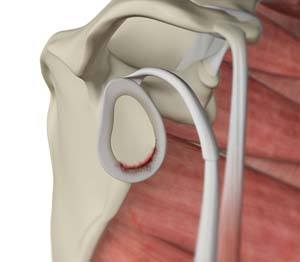Shoulder Joint Tear (Glenoid Labrum Tear)

Anatomy of the Shoulder Labrum
The shoulder joint is a ball and socket joint. A ball at the top of the upper arm bone (the humerus) fits neatly into a socket, called the glenoid, which is part of the shoulder blade (scapula). The labrum is a ring of fibrous cartilage surrounding the glenoid, which helps in stabilizing the shoulder joint. The biceps tendon is attached inside the shoulder joint at the superior labrum of the joint. The biceps tendon is a long cord-like structure that attaches the biceps muscle to the shoulder and helps to stabilize the joint.
Shoulder Labral Tears
Traumatic injury to the shoulder or overuse of the shoulder by excessive throwing or weightlifting can cause a labral tear. In addition, the aging process may weaken the labrum, leading to injury secondary to wear and tear.
Symptoms of Shoulder Labral Tears
A shoulder labral tear injury can cause symptoms such as pain, a catching or locking sensation, decreased range of motion and joint instability.
Types of Shoulder Labral Tears
The most common types of labral tears include:
SLAP tear: The term SLAP (superior–labrum anterior-posterior) refers to an injury of the superior labrum of the shoulder at the attachment of the biceps tendon.
Bankart tear: A Bankart tear is an injury to the labrum that leads to recurrent dislocations and arthritis of the shoulder.
Posterior labrum tear: This type of labrum tear is rare, but may be caused by repeated internal impingement, where the extreme extension and external rotation of the shoulder joint cause pinching of the bulged part of the arm bone against the lining of the shoulder joint cavity.
Diagnosis of Shoulder Labral Tears
Your doctor may suspect a labral tear based on your symptoms and medical history. Several physical tests will be performed to evaluate the range of motion and stability of your shoulder. X-rays, computed tomography (CT) scan or magnetic resonance imaging (MRI) scan, with a contrast medium, may be ordered to determine the presence of tears. Diagnosis of a labral tear can also be confirmed through shoulder arthroscopy.
Conservative Treatment of Shoulder Labral Tears
Your doctor may initially suggest conservative approaches such as anti-inflammatory medications and advise rest to relieve symptoms. Rehabilitation exercises may be recommended to strengthen the rotator cuff muscles. If the symptoms do not resolve with these conservative measures, your doctor may recommend arthroscopic surgery.
Surgical Treatment of Shoulder Labral Tears
During arthroscopic surgery for SLAP tears, your surgeon examines the labrum and the biceps tendon. If the damage is confined to the labrum without involving the tendon, then the torn flap of the labrum will be removed. In cases where the tendon is also involved or if there is the detachment of the tendon, absorbable wires or sutures will be used to repair and reattach the tendon.

